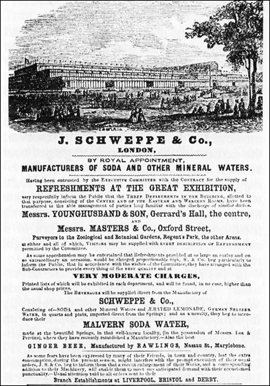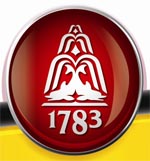
| 
|

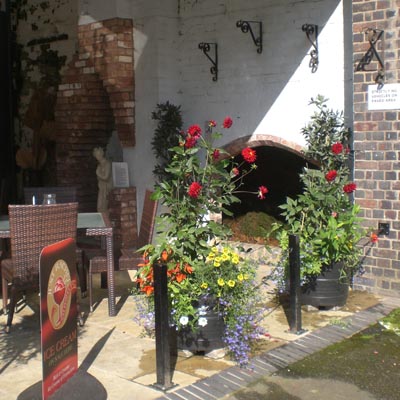
Bottling Works Spring
NGR 77463 45983
Site Number: C121
By Bruce Osborne and Cora Weaver (C) 2012
Area 1. Malvern Town Centre Springs and Wells
Malvern Hills, England
Description: In a hole in the wall is a rare exposure of Bromsgrove sandstone bedrock from which spring water trickles. Once it contained a tank that was badly rusted.
A high covered entry at no.10 Belle Vue Terrace leads to a yard and brick-built industrial building that was once the bottling works of Walter Becker Burrow and John Severn Burrow. The Burrow brothers came from St Martin's parish in Worcester and Walter attended Mr Colville's school in Silver St. where he became a close friend of James Dyson Perrins (1823-1887). When Walter (1825-1913) left school in 1839 he became an apprentice at Lea & Perrins (chemists) branch shop at Kidderminster but in 1845 transferred to Worcester as a warehouseman.
Lea and Perrins' Malvern shop opened in 1849 selling soda water and the Burrows - both described as Chemist and Druggist - acted as managers. They were so successful that in 1851 a document was drawn up whereby for 14 years from 1 Jan 1852 the Burrow brothers became partners with Lea and Perrins, the firm being known as Lea Perrins and Burrows. In 1854 Lea and Perrins purchased an old property on Belle Vue Terrace, had it demolished and, using as many salvageable materials as possible and the architectural skills of Edmund Wallace Elmslie of London, built two houses, shops and offices for the firm.[1] Elmslie later moved to Malvern and designed some of its finest buildings. With the success of the Worcestershire Sauce business Lea & Perrins sold their three Chemist's shops at Kidderminster, Cheltenham and Malvern, and Burrows became sole proprietors at Malvern.[2] They produced the `Alpha Brand' natural water from St Ann's Well, selling this product well into the 20th century.
An article in the Malvern Gazette 24 March 1922 throws more light on the Schweppes involvement in the 1920s. The firm of Messrs W & J Burrow was founded 1850 by Walter B Burrow and John Severn Burrow (died 1916) and bought by the present company (Schweppes) in 1917. Thereafter they used the St Ann's Well water more than had been done previously and in 1922 were the sole bottlers there. The present firm had built new tanks behind the factory: the first one held 14,000 gallons; the 2nd held 3,000 galls and the 3rd held 6,000 galls. Two new tanks being constructed in March 1922 would hold 15,000 galls and gave work to several Malvern men for several months. The tanks are lined with white glazed bricks and covered with glass to stop impurities getting in. The present company had expanded the premises; they had built a new mineral water factory; they had acquired a gallery/premises and converted it to a labelling and storing room 90' x 30'; they took over some old stables and Warner's old yard and made a new dispatching depot; bottles were scrupulously soaked, brushed and rinsed before use. Previously the max output had been 70 dozen bottles a day but now with modern machinery the firm was producing 400-500 bottles a day with the same number of staff. Carbonic acid gas was now being bought in because it was more hygienic than in the old days when people made it themselves. They had slate solution tanks for the lithia and soda water because it prevented metallic contamination and the water was conveyed from the tanks to the pump in tin pipes. There was a sugar-mixing plant to make the syrup which with fruit essences made the sweetened waters. There were automatic filling machines and crown corkers. Labelling was done partly by hand and partly by machine. The works manager was George Maycock who came to Malvern in June 1919 to oversee the construction of the new factory. The architect was Thomas Holds of Malvern and the builders were J Evans and Son of Newtown.
As a further precaution the water was tested daily before being allowed into the tanks.[3] It confirms that much restructuring of the business was taking place at the time of the Schweppes take over. A sale brochure in the hands of a Friend of Malvern Springs and Wells dated September 1920, details 1330 sq yards of driveway and premises, leased to W & J Burrow, included factory premises newly erected on part of the site of the old Belle Vue stables. The premises comprised bottling shed and boiler house. At the same sale several other building along Belle Vue Terrace were for auction.
Burrows also owned the water rights to the Holy Well, and in the 1880s were bottling at both sources. In 1897 they entered into a contract with the Bright family of Barton Court and secured water rights to the Pewtriss Well on the west of the British Camp. Burrows' greatest accolade came in April 1882 at the International Water Exhibition at Frankfurt, where they received the only prize awarded to English mineral waters. "It is worthy of record that the water which secured this exclusive award had been bottled ten years, and when subjected to examination was found perfectly sweet and good".[4] They were granted Royal Warrants of Appointment for the supply of water to Princess Mary Adelaide in 1895, King George V in 1912 and later King George VI, though by these latter dates the business was being managed by Walter Burrow's grandson J B Graham. Their water was drunk in Australia, Peking, New Zealand, Denmark and France, and at home was used by the rich and famous - including the Duke of Bedford, Duke of Wellington, Duke and Duchess of Marlborough, Viscount Castlereagh, Sir Oswald Mosley, Charles Darwin, Stanley Baldwin and the Prime Minister, Mr Asquith.[5]
Schweppes eventually sold the bottling works in November 1958 because they were 'centralising their activities at other premises on the slopes of the Malvern Hills.'[6] After the closure of the Bottling Works in the 1950s the premises were taken over by Clarke Roxborough who still own the site.
The Burrows premises at Belle Vue Terrace up until 2012 was occupied by a pine furniture retailer and in the yard, to the right through a hole in the wall, water trickles from the exposed bedrock. Here the 230 million year old Triassic Bromsgrove red sandstone is overlain by the even older but broken Precambrian rocks set in finer material that is about 20,000 years old. The water emerges from the juncture. The sandstone is easily excavated and this would have been advantageous to building works in more recent times. The overlying layer resulted from erosion materials accumulating during the ice age.[7] The resulting spring would not have been the spring used by the bottling works because its flow rate is insufficient. In Aquae Malvernensis (1994) we suggested that it could perhaps be converted to a small decorative fountain. Following a puzzling, unexplained surge of interest from the public after we published, the proprietor, who was initially unaware of our publication, responded to this suggestion by remodelling the portal and interior and regularly decorating with flowers and a statue.
Sequencing Illustrations at the top of the page:
1. The Bottling Works Spring in 2012.
2. Burrow's Advertisement.
3. The spring when first identified in the early 1990s, complete with iron tank in the recess.
Footnotes:
[1] HWRO ref.009:3 BA 6491/2.
[2] information supplied by Brian Keogh, former employee at Lea & Perrins.
[3] Malvern Gazette 17 January 1913.
[4] Malvern Advertiser 29 April 1882.
[5] Malvern Gazette 17 Jan 1913.
[6] WRO ref. 705:876 BA 8077/47 (x) Sale of Schweppes building, 10 Belle Vue Terrace.
[7] Explore Great Malvern, (2003) Herefordshire and Worcestershire Earth Heritage Trust.
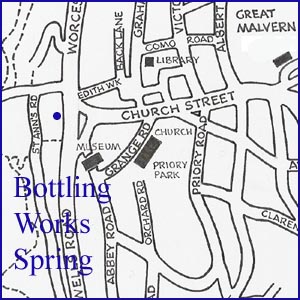
Website: Click Here
SUPPLEMENTARY INFORMATION

Celebrated Springs of
THE MALVERN HILLS
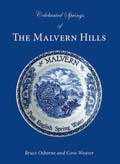 A definitive work that is the culmination of 20 years researching the springs and wells of the Malvern Hills, published by Phillimore. This is the ideal explorers guide enabling the reader to discover the location and often the astounding and long forgotten history of over 130 celebrated springs and wells sites around the Malvern Hills. The book is hard back with dust cover, large quarto size with lavish illustrations and extended text. Celebrated Springs contains about 200 illustrations and well researched text over a similar number of pages, together with seven area maps to guide the explorer to the locations around the Malvern Hills. It also includes details on the long history of bottling water in the Malvern Hills.
A definitive work that is the culmination of 20 years researching the springs and wells of the Malvern Hills, published by Phillimore. This is the ideal explorers guide enabling the reader to discover the location and often the astounding and long forgotten history of over 130 celebrated springs and wells sites around the Malvern Hills. The book is hard back with dust cover, large quarto size with lavish illustrations and extended text. Celebrated Springs contains about 200 illustrations and well researched text over a similar number of pages, together with seven area maps to guide the explorer to the locations around the Malvern Hills. It also includes details on the long history of bottling water in the Malvern Hills.
Written by Bruce Osborne and Cora Weaver, this book is available on-line for £15.00 (delivered UK) - click Malvern Bookshop on the green panel top left. Alternatively send a cheque payable to Cora Weaver with your name and address to 4 Hall Green, Malvern, Worcs. WR14 3QX.
1) TOPOGRAPHICAL LOCATION:
Malvern Hills - arguably Britain's original National Park
2) LANDSCAPE:
Built Up Location3) INFORMATION CATEGORY:
A Spring, Spout, Fountain or Holy Well Site4) MALVERN SPRING OR WELL SITE DETAILS:
Site with Malvern WaterSt Werstan Award
 5 SPLASHES - Prime 'Must See' Site
5 SPLASHES - Prime 'Must See' Site Water Bottling - Past or Present
Water Bottling - Past or Present5) GENERAL VISITOR INFORMATION:
Access On FootFree Public Access
Disabled access
Accessible All Year



